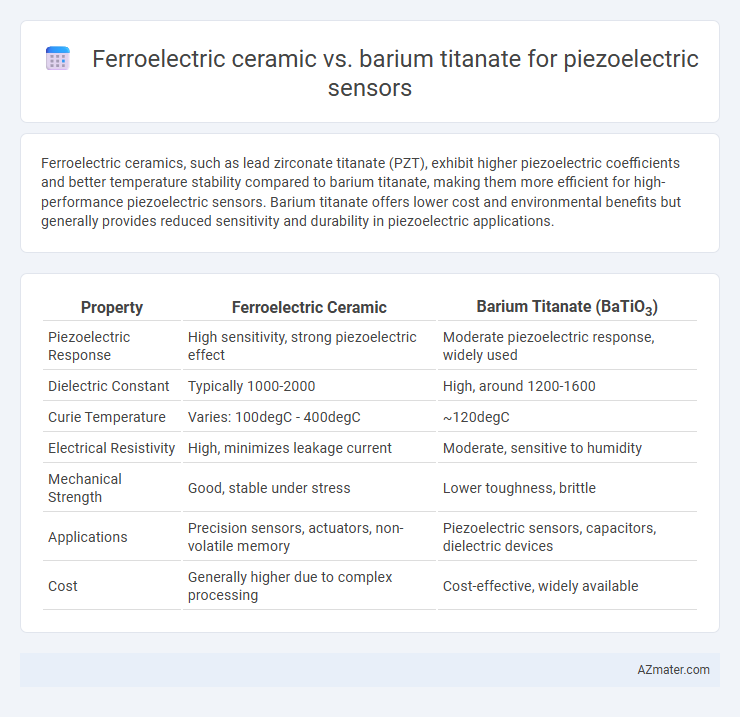Ferroelectric ceramics, such as lead zirconate titanate (PZT), exhibit higher piezoelectric coefficients and better temperature stability compared to barium titanate, making them more efficient for high-performance piezoelectric sensors. Barium titanate offers lower cost and environmental benefits but generally provides reduced sensitivity and durability in piezoelectric applications.
Table of Comparison
| Property | Ferroelectric Ceramic | Barium Titanate (BaTiO3) |
|---|---|---|
| Piezoelectric Response | High sensitivity, strong piezoelectric effect | Moderate piezoelectric response, widely used |
| Dielectric Constant | Typically 1000-2000 | High, around 1200-1600 |
| Curie Temperature | Varies: 100degC - 400degC | ~120degC |
| Electrical Resistivity | High, minimizes leakage current | Moderate, sensitive to humidity |
| Mechanical Strength | Good, stable under stress | Lower toughness, brittle |
| Applications | Precision sensors, actuators, non-volatile memory | Piezoelectric sensors, capacitors, dielectric devices |
| Cost | Generally higher due to complex processing | Cost-effective, widely available |
Introduction to Piezoelectric Sensors
Piezoelectric sensors convert mechanical stress into an electrical signal using materials with piezoelectric properties, where ferroelectric ceramics like lead zirconate titanate (PZT) and barium titanate (BaTiO3) are prominent. Ferroelectric ceramics exhibit strong polarization and stable piezoelectric coefficients, often surpassing barium titanate in sensitivity and temperature stability for sensor applications. Barium titanate, a lead-free alternative, offers good piezoelectric response with environmental benefits, making it suitable for less demanding conditions and eco-friendly sensor designs.
Overview of Ferroelectric Ceramics
Ferroelectric ceramics, including barium titanate, are critical materials in piezoelectric sensors due to their ability to exhibit spontaneous polarization that can be reversed by an external electric field. These ceramics possess high dielectric constants and strong piezoelectric coefficients, making them ideal for converting mechanical stress into electrical signals. Barium titanate, a well-known ferroelectric ceramic, offers excellent electromechanical coupling but can be limited by temperature stability and aging effects compared to other advanced ferroelectric materials.
Understanding Barium Titanate
Barium titanate is a widely studied ferroelectric ceramic known for its strong piezoelectric properties, making it a key material in sensor applications. Its high dielectric constant and ferroelectric phase transitions enhance sensitivity and signal response in piezoelectric sensors. Compared to other ferroelectric ceramics, barium titanate offers stable performance at room temperature and is cost-effective for mass production.
Material Structure and Composition
Ferroelectric ceramics and barium titanate differ primarily in their crystal structure and chemical composition, which directly influence their piezoelectric properties. Ferroelectric ceramics, such as lead zirconate titanate (PZT), possess a perovskite crystal structure with a complex composition that includes lead, zirconium, and titanium ions, providing high piezoelectric coefficients and stability. Barium titanate (BaTiO3), also with a perovskite structure, consists of barium, titanium, and oxygen ions and offers strong piezoelectric responses but generally lower Curie temperatures and mechanical strength compared to PZT ceramics.
Piezoelectric Properties Comparison
Ferroelectric ceramics such as lead zirconate titanate (PZT) exhibit superior piezoelectric coefficients (d33 values up to 600 pC/N) compared to barium titanate (BaTiO3), which typically shows lower piezoelectric responses around 100-200 pC/N. The higher Curie temperature and enhanced electromechanical coupling factors of ferroelectric ceramics enable more efficient energy conversion and greater sensitivity in piezoelectric sensors. Barium titanate's lower dielectric loss and environmental compatibility make it suitable for specific applications but limits its performance relative to advanced ferroelectric ceramics in sensors requiring high precision and output.
Dielectric Constant and Sensitivity
Ferroelectric ceramics such as lead zirconate titanate (PZT) typically exhibit a higher dielectric constant compared to barium titanate (BaTiO3), enabling greater charge storage and enhanced piezoelectric sensitivity. Barium titanate's dielectric constant ranges from 1000 to 1400, whereas PZT ceramics often exceed 1000 to 2000, directly influencing the sensor's ability to convert mechanical stress into electrical signals. The elevated dielectric constant in ferroelectric ceramics translates to improved sensitivity in piezoelectric sensors, making them preferable for applications requiring high precision and responsiveness.
Temperature Stability and Operating Range
Ferroelectric ceramics such as lead zirconate titanate (PZT) exhibit superior temperature stability and a broader operating range compared to barium titanate, maintaining consistent piezoelectric properties across temperatures from -40degC to 250degC. Barium titanate sensors typically operate effectively within a narrower temperature range around -20degC to 125degC, with reduced stability and potential depolarization near the Curie temperature (~120degC). The enhanced thermal endurance of PZT makes it more suitable for high-temperature and variable thermal environment applications in piezoelectric sensors.
Durability and Reliability Factors
Ferroelectric ceramics, including barium titanate, exhibit high piezoelectric coefficients but differ significantly in durability and reliability for sensor applications. Barium titanate offers excellent dielectric properties and thermal stability but is prone to aging and domain wall pinning, which can reduce sensor lifespan under cyclic loading. Advanced ferroelectric ceramics often incorporate dopants or engineered microstructures to enhance mechanical robustness and resistance to depolarization, resulting in superior long-term reliability compared to pure barium titanate-based sensors.
Cost-Effectiveness and Scalability
Ferroelectric ceramics, especially lead zirconate titanate (PZT), offer superior piezoelectric properties with well-established manufacturing processes, making them cost-effective for high-volume sensor production. Barium titanate, while less expensive and environmentally friendly due to its lead-free composition, typically exhibits lower piezoelectric efficiency and poses challenges for large-scale fabrication. The scalability of ferroelectric ceramics is enhanced by mature industrial techniques, whereas barium titanate requires further material optimization to compete in mass-market sensor applications.
Application Suitability and Industry Use Cases
Ferroelectric ceramics, including lead zirconate titanate (PZT), offer superior piezoelectric coefficients and thermal stability, making them ideal for high-precision industrial applications such as vibration monitoring and ultrasonic imaging. Barium titanate provides an eco-friendly alternative with moderate piezoelectric performance, suitable for cost-sensitive consumer electronics and automotive sensors where environmental regulations favor lead-free materials. Industry use cases for ferroelectric ceramics dominate in aerospace and medical devices, while barium titanate finds growing adoption in flexible electronics and renewable energy harvesting systems.

Infographic: Ferroelectric ceramic vs Barium titanate for Piezoelectric sensor
 azmater.com
azmater.com